Day 150 Friday 1st OctoberIndiaChennai Container Terminal – depart for Singapore The container ship is not designed to take passengers; in fact this is the first time since RCL began twenty-five years ago that it has taken “supernumeraries” such as us. The officers and crew, about 25 in total, are mainly Thai with a few Burmese; they are welcoming, friendly and happy to show us what they do. The Captain has invited us to eat with him and his senior officers; we were shown our places in the officers’ mess at the end of the table of six shortly after we arrived. Everyone sits in the same place each mealtime even if that means leaving two empty spaces between us and the Captain. We are accommodated in what is called the “spare cabin” which has it’s own shower and loo. It has a desk, small table, cupboard, bench and bunk, all fixed to the floor. The single bed is a sqeeze for two and we do not yet know whether it will be safe to sleep on the narrow bench next to the table without falling off if the ship rolls so neither of us has volunteered, prefering instead to sleep head to toe in the bunk! We have three portholes that we can open and through which we can watch the ship being loaded with containers – 501 on this trip. 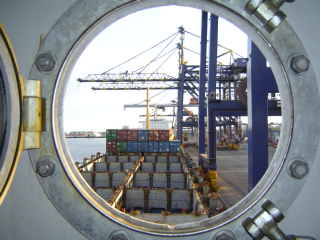 Each time a heavy one is placed down by one of the huge overhead cranes the ship leans slightly to that side then settles back into a balanced position. As we got dressed this morning we watched the view from our two forward-looking portholes being obscured by the seventh level of containers. 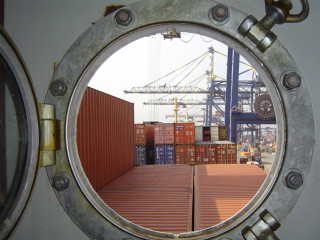 Being spectators in the middle of all of this immense activity in the terminal is quite awe-inspiring. With a backdrop of containers stacked four or five high, trucks carrying containers constantly shuttle in alongside the ships, huge overhead cranes manoeuvre along tracks into position then pick up a container, hoist it in the air, swing it into position and lower it down with a CLUNK onto the stack on the ship. Men in hard hats and orange overalls crawl over and around the containers locking them into position and securing them where necessary; they wear harnesses but step un-roped across gaps several containers deep and clamber up the doors of containers at the top of the stack with no assistance and no safety straps. We felt giddy just watching. The management of the terminal was taken over from the Government by P&O who installed new equipment and built a stylish ship-inspired terminal office building that opened in June this year. India’s exports increased by 20% and imports by 28% last year with Chennai Container Terminal, the second largest in India after Mumbai, handling 600,000 containers, this is expected to increase to 800,000 this year. In a mad dash to a market stall just outside the port for fear of the ship sailing without me, I spent our final rupees on supplies of nut brittle for the journey. Tim sent a couple of last minute e-mails from the CCT office to thank various people for their support during our time in India and to let them know that we were leaving, then we rushed back to the ship, already well past the deadline of 10am that the Captain had given everyone. Despite the Chakiat representative trying to tell us that we did not need to rush we felt that we ought to obey the Captain. As it turned out, there was no need to panic. At ten o’clock the ship was still expected to depart at midday but as we ate lunch we were told that the departure had slipped to 2pm…then 3.30pm…by dinnertime eight more containers still had to be loaded, there had apparently been some delay in bringing the containers to the port. On hearing the engine start at 7.30pm we rushed up to the bridge and stood outside watching the Captain and the Pilot guide the ship out of the harbour with the help of tugs at the bow and stern. We were away; the lights of Madras were quickly behind us, the vast Indian Ocean in front. The Captain spread out the charts and showed us the route – southeast across the Bay of Bengal between the Andaman and the Nicobar Islands to Port Kelang, Malaysia, near Kuala Lumpur, where we will stop for ten hours, then through the Malacca Straits to Singapore. We are not now expected to reach Singapore until 7th October. We had thought that there was a slim chance that we would get there on the 5th, just in time to meet up with some British friends who are passing through on their way to Australia. Disappointingly, that is now highly unlikely. Day 151 Saturday 2nd OctoberIndia-SingaporeBay of Bengal - Merchant Vessel Jaru Bhum Sleeping top to toe last night meant that we slept better in our single bunk than we had yesterday. The sea was a little rougher than when we left Chennai and it was pouring with rain, the horizon a merge of grey sea and sky. The air temperature was still warm as we ventured along the side of the ship underneath the overhanging containers 113metres to the front of the ship. The rain prevented Joanne from standing on the end, wind in her hair, arms outstretched…mmm, perhaps it wouldn’t have been quite as romantic as “Titanic” anyway. Instructions in the actions to be taken in case of man overboard, fire, abandon ship and attack by pirates were reassuring but also rather sobering. 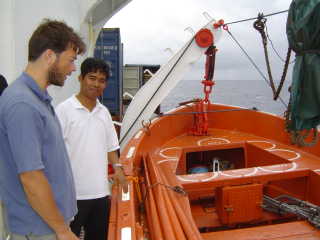 We have lifejackets in our cabin and have now been issued gloves and hard hats; we know what the alarm signals are, where to muster in case of fire and which wooden lifeboat we are to go to in case we are ordered to abandon ship. We also know why the duty officer must check that the doors of the ship are locked from the inside: because Chennai and the Malacca Straits are two of the areas most notorious for piracy. The pirates are usually, we are told, former seamen armed with machine guns who, if successful in boarding the ship, usually aim for the Captains cabin with the intention of stealing the ships money. It is not uncommon for them to take a hostage so that the crew do not fight back. Despite this the crew are not armed, aiming instead to prevent boarding by posting a watchman at the stern and preparing to fire water jets at approaching pirates. As I am the only female on board and, therefore, a likely hostage target our plan on pirates attacking the ship is for me to hide in the tiny cupboard in our cabin where Tim will stick a rucksack over my head and bundle other clothes and bags on top – alternatively, we grab the video camera and dash for the top of the ship from where we can film the action! I sincerely hope we do not have to decide which plan of action to take! We were both given tablets by the medic as it was noticed that Tim has just developed a sneezing cold and that Joanne is suffering from seasickness. The sea got rougher throughout the day until there was quite a swell by the evening. I jammed myself into a corner in the Mess and watched a DVD with the Captain then went to bed early figuring that the best method of coping with a rolling ship is to lie flat, preferably asleep. Day 152 Sunday 3rd OctoberIndia-SingaporeBay of Bengal - MV Jaru Bhum Breakfast was unusual today: a sort of set scrambled egg in a bowl cooked with stock, chillies and onions and served with a plate of rice. Breakfasts are similar to lunch and dinner, the only difference being that we do not have a desert at breakfast. The food is Thai and meals so far are variations on a plate of rice served with chicken or pork cooked in spicy vegetable stock with lots of red chillies. Three different types of meat were served last night to accompany a plate of rice – chicken in stock, a plate of beef with ginger and red pork sausages. Desert is usually a plate of fruit but variations have so far included chunks of pumpkin in a sweet egg sauce and chunks of something resembling potato in a sugary liquid – about as appetising as it sounds. The food is becoming less recognisable as we progress and we watch the Captain to help work out how we should be eating whatever it is that is presented to us. First sighting of dolphins from the ship this morning as Joanne sat outside the bridge watching the huge horizon – nothing else in sight except a few flying fish whizzing along the surface then diving into the water. This afternoon we saw another couple of dolphins that played in the wake of the ship. A few birds, moths and large butterflies are hitching a lift on the ship, flying around the containers that they may have been in when we left India; the containers containing perishable goods like onions and potatoes have their doors left open such that the smell of onions is all pervading. It will not be the smell of the sea but a smell of onions that will remind me of this sea voyage! At 10.30am we took part in the crews monthly “Abandon ship” and “Fire” drills. 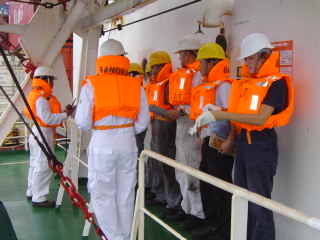 On hearing the alarm signal we donned our lifejackets and helmets and ran to join the rest of the crew of the port lifeboat where we answered various questions, ran through the procedures for launching the lifeboat and practised taking up our seats in it. 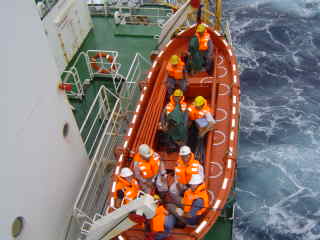 We watched the starboard lifeboat crew start their engine (we in port have to row or are towed), learnt about flares and rescue beacons while being buffeted on deck by the wind then were dismissed by the horn. Back to the cabin to stow our lifejackets then out again on hearing the “Fire” alarm, equipped with helmets and gloves to muster at the stern. We are to provide support to the First Aid Team. We watched as the Second Emergency Team donned breathing apparatus and fire proof suits then followed the First Team down into the hot and noisy engine room. 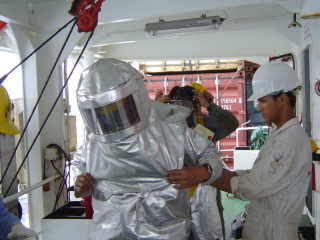 The exercise was to test and train the crew in dealing with a fire in the engine room. The First Aid Team, including us, was called in to stretcher a collapsed man up from the engine room to the deck where he was treated and recovered. The idea of spending long in the hot bowels of the rolling ship was not something I relished. Thankfully I was needed to help carry the stretcher so was back out on deck before my brain had had time to tell my stomach to feel sick. 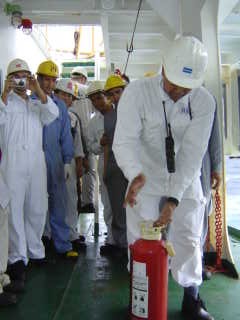 The Chief explained to us when to use water, powder and foam extinguishers and the First Officer demonstrated how to use a foam extinguisher. Use of the water hoses was practised off the stern in the same way that they would be used in the event of a pirate attack on the ship. 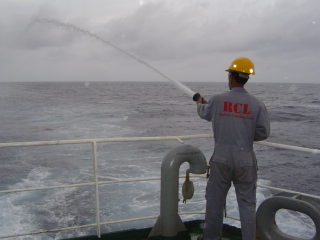 It was all rather different to being on a ferry or cruise but having experienced what would happen in the event of an emergency was reassuring. We actually enjoyed the morning, felt less seasick with all the activity on deck and, judging by the amount of photos taken of us involved in the activities, we think the crew were amused to have a couple of different people taking part and filming them. They were certainly entertained by the video footage we had taken of them in action when we played it back at the end of the presentation about our journey that we gave to the officers and crew after lunch. This afternoon was a free afternoon for all but those on duty and tonight a party was held to say farewell to the Chief Officer who will leave the ship in Singapore after 7 months on board. He is going back to his family in Rangoon, Myanmar (Burma), where he will take a two-week family holiday then study for his Masters Ticket so that in the next couple years he will captain a ship. The party kicked off with a casual dinner in the crew mess - a random mix of dishes from fish stew to chips and noodles to chicken drumsticks prepared by the chef and whoever wanted to turn their hand to cooking for the afternoon. Cans of coke, beer and even bottles of whiskey were laid out along with the food on blanket covered tables and everyone tucked in together. 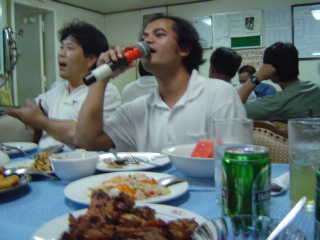 Initially accompanied by a DVD of Dire Straits in concert Tim joked quietly about karaoke and, sure enough, minutes later out came the microphone and the karaoke DVDs. 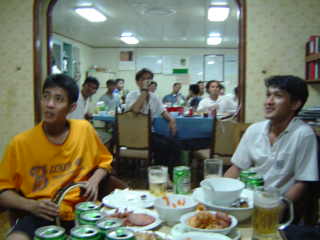 First the Captain, who was clearly happy to lead karaoke by example, then it was our turn…with only one DVD in English with mostly unrecognisable songs sung by bopping Thai girls the choice was limited but dodging the mic was no option; Joanne stepped up to dance and sing to “Stupid Cupid”. We thought that that would be sufficient but after several Thai songs the mic returned to us and we sang along to two Corrs songs. Despite the cheers and round of applause, it was all mortifyingly embarressing, redeemed only slightly by the fact that we are unlikely to ever see any of them again. The ship is on autopilot, as it has been since we got out into the open sea, with one officer on watch. Hopefully there will be no problems tonight as the crews drills may not be quite as sharp later tonight as they were when we practised this morning. Day 153 Monday 4th OctoberIndia-SingaporeBay of Bengal - MV Jaru Bhum Breakfast was simple this morning (perhaps because the chef had a late night last night) - omelette fried in lots of oil and served on a plate of boiled rice. Chili sauce added a bit of interest but could not quite compensate for the oily taste which did not much help my slightly rocky tummy. Lunch was the first meal we have eaten with chopsticks – noodles in a soy sauce sprinkled with spring onions, beef strips and served with a stock of bobbing meatballs. It is not surprising that being in a small space with little to do eating becomes one of the most interesting activities – no two meals have yet been the same and for us the added amusement is in watching the others in order to work out how best to eat what is placed in front of us. We had intended to spend this time catching up on personal admin – replying to e-mails we had not yet found time to reply to, e-mailing friends and family, doing our accounts, sorting and naming photos and so on. Joanne had every intention of reading the book about India that she had been given when we first arrived in Bombay and that she carried around for the seven weeks we were there reading only a few pages. 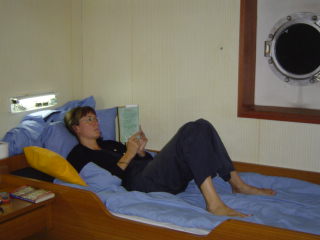 We have done a little admin, we have also made use of the washing machine (a rare and much appreciated opportunity) and Joanne has read some of her book. We have also caught up on sleep! Though it may be just that we do not sleep particularly well at night so catch up with a snooze during the day – being horizontal seems to be the best way of coping with seasickness. The tablets have helped but that icky feeling is always threatening to return. Tim does not seem to suffer at all! Perhaps because passengers do not travel on these ships there are no rules about where we can go so we have been able to explore the ship and learn about the crew and what they do. This morning we walked again to the focsle (the very front of the ship) where we stood watching the ship plough through the waves. 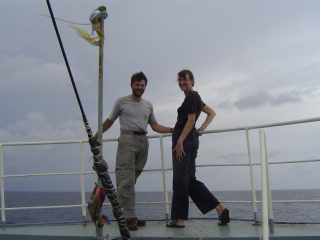 The second attempt to recreat the “Titanic Moment”! The Chief Officer took Tim down into the hold, clambering down ladders and squeezing through access holes in an attempt to see our container but it is packed in with containers on all sides so is not possible to reach. We do know it is there even if we cannot see it: there was a moment of doubt when we were called to the bridge to give the Captain the container number so that he could send details by fax to Singapore. The Chief Officer looked it up on the loading list and could not find it. On his second attempt he found that it was in the first hold – phew! We are welcome on the bridge, the officers happy to show us the ships position and offer advice on our route using the charts. I especially am happy to spend hours on the bridge deck just watching the sea; it is relaxing and blows away feelings of seasickness. It is not as rough today, the swell calmed as we passed between the Nicobar and the Andaman Islands. The sky is still cloudy and it has rained intermittently since we left India, yet the air remains a pleasant t-shirt temperature. No beautiful sunsets over the sea yet, nor star-scapes due to the cloud cover. Apart from seeing one of the Nicobar Islands in the distance this morning, the horizon has not been broken by land or other vessels since we left the Indian coast. We are due to reach the Malacca Straits between Indonesia and Malaysia tomorrow morning where, according to the Captain and the Chief Officer, there will not only be more shipping but also a high risk of piracy. We saw reports of attacks on two ships early this evening by eight pirates armed with machine guns, they took ship documents and equipment and took the Captain and Chief Engineer hostage. The Indonesian, Malaysian and Thai authorities organise naval security but, just in case, a watchman will be posted at the back of the ship from tonight. Day 154 Tuesday 5th OctoberIndia-SingaporeBay of Bengal - MV Jaru Bhum 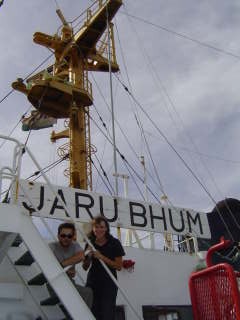 The sun shone for the first time since we left Chennai and we saw a beautiful sun set over a vast sea by that stage dotted with a few fishing boats and other merchant vessels. The sea was incredibly calm and the clouds reflected off the smooth surface. Tim caught up on some e-mails and is on the way towards clearing the in-box; this is a mighty task as we not only receive e-mails from family and friends and people who are helping us make arrangements for our journey but also many e-mails from people all over the world who offer advice or wish us well. We respond to everyone but this can take some time! Day 155 Wednesday 6th OctoberMalaysia – MV Jaru BhumWe arrived at Port Kelang, Malaysia, at 4am this morning but anchored off until a space was free for the ship to dock at North Port at 11.30am. 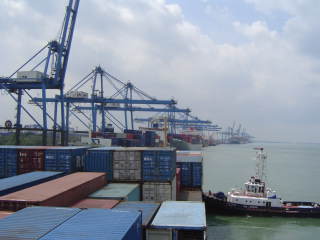 The ships pilot wondered who we were and asked, quite seriously, whether we were on the bridge taking pictures as prospective purchasers of the ship! The sunset as we prepared to leave North Port was awesome. 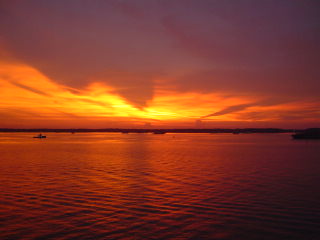 We expect the ship to leave Port Kelang late tonight and arrive in Singapore tomorrow evening or Friday morning. Day 156 Thursday 7th OctoberMV Jaru BhumArrival Singapore We woke this morning to a serious storm, tremendous claps of thunder accompanying flashes of lightning all around us. The pouring rain and poor visibility continued all morning but it cleared up a little in the afternoon. We are following a shipping lane down the Malacca Straits to Singapore, about twelve miles out from Malaysia, the nearest coastline, yet we passed tiny fishing boats, one man in each bouncing along on the choppy water. We are told that several of them are brought out together on one large ship then left to fish in an area for the day. They looked vulnerable so far from land and so close to huge ships ploughing past. Going for a meal is one of the interesting activities on board, partly because we never know what culinary delight will be placed in front of us, and even when it is in front of us we’re not always sure what it is…nor how to eat it. 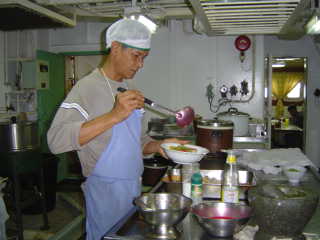 The chef had excelled himself today and had clearly saved the most colourful and interesting (not to mention unidentifiable) meal until last. 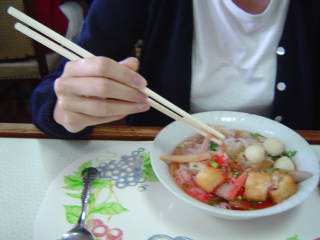 Presented to us in large dishes was a mixture of flat wheat noodles and thin rice noodles topped with chopped up crispy egg puff, slices of pork, smooth fish tasting balls, fishy tasting un-textured strips, spring onions, garlic, and an odd octopus leg; and to make it a little more challenging this concoction had a bright pink sauce and was to be eaten with chopsticks, with a little assistance from a spoon. Try eating that without messing up your white t-shirt! Dessert was equally colourful – a small bowl of crushed ice and a thin cloudy liquid with bright green bits in the bottom that looked like thin green beans crossed with caterpillars. Joanne thought it unusual but good so ate Tim’s share, he was not quite so sure. It turned out that it was tapioca, but not as we know it. 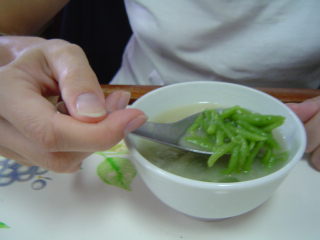 After lunch Tim was taken on a tour of the engine room – very hot, amazingly neat and clean, a hive of activity. 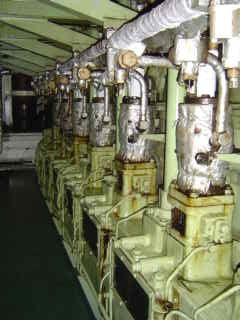 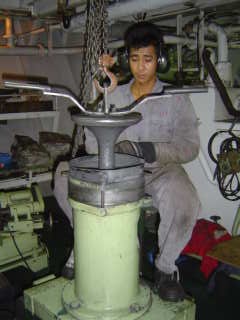 He then went to the bridge and tried his hand at helming (steering the ship past some small fishing boats), under the watchful eye of the Captain and the Second Officer. 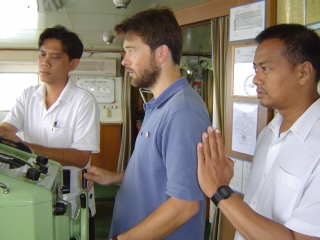 We docked at Singapore at 6pm – a vast port dealing with approximately 300 ships each day. The pilot who guided the ship in and directed the tugs that pushed the ship into position expressed an interest in what we were doing an in our car. His father, a priest, used to drive a Morris Oxford Traveller (estate car) that, on occasions, with the back seat folded down, doubled up as a hearse! Having had our passports stamped by the immigration officer we were surprisingly sad to be waving goodbye to the officers and crew of the MV Jaru Bhum who had been such good hosts for the last few days. Day 157 Friday 8th OctoberSingaporeOur priority today was to decide what to do about the car that is in a container unloaded into the port last night. If it is not removed from the port by Sunday evening we will start incurring port storage charges, if it to be shipped on then it can stay in the port for nine days with no charges. Taking it out of the port also incurs charges and requires an agent. If we decide to remove the car from the container and drive in Singapore we will have to pay yet more charges and wade through a great deal of bureaucracy. Before we could make a decision we had to garner a few more facts. RCL, the shipping company that shipped us from India to Singapore, helped us immensely today by explaining some of our options, finding out which shipping companies ship from here to Western Australia, (unfortunately RCL ships to East, not West Australia) and giving us the use of an office where we were supplied with coffee, tea and the use of a local phone – invaluable. We were taken for lunch with a Vice-President, Assistant General Manager and Sales Executive from RCL; the Assistant General Manager and Head of Singapore Agency, Henry Koh, studied at University in London and it was amusing to hear him, Pornchai and Simon tell us their thoughts on Singapore and how it compares to other countries and cities. We had been considering driving to Malaysia then taking a ferry to Sumatra and driving and ferrying through Indonesia to Surabaya (Java) or Bali and shipping from there to Australia. However, to drive from Singapore to Malaysia will incur additional Singapore charges and we, as yet, do not know if it is even possible to take a car ferry to Sumatra. RCL could take the container on to Jakarta but if we wish to do that we would have to commit today and we do not want to do that without confirmation that we can ship from Indonesia to Australia. Another issue that we must take into account is security: though the British Foreign Office advice is that the risk to individuals is not high but there is a general threat to Westerners. After many phone calls we have committed to take the car out of the port here and apply for the necessary permissions from the Singapore Land Transport Authority and the Automobile Association of Singapore. Simon and Henry at RCL have arranged for their “trucking company” to take the container out of the port and transport it to their warehouse facility tomorrow, thus ensuring that we do not have to pay storage charges at the port. We will apply for Customs clearance and hope to get it out on Monday. This effectively keeps our options open while we investigate the possibilities in more detail but, unfortunately, means that we have to pay for trucking the container out of the port, port fees, insurance, AA admin fees, and LTA fees to drive on Singapore roads. We were kindly invited to stay in Singapore with Stuart Mort, a British chap who has been based in Singapore working for Oracle for a year – his website www.smort.info is a source of all sorts of interesting facts. 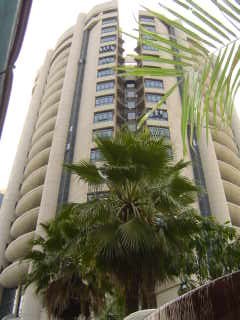 Stu's apartment is in a smart modern condo of several towers with a pool, gym, tennis and squash courts on River Valley Road, close to the city centre. 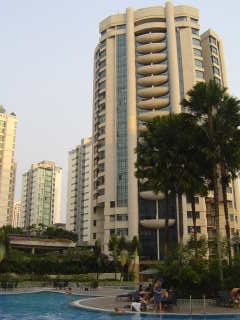 Paula is a friend of his from home who is on a three month sabbatical from Oracle, UK, and is stopping off in Singapore on her way from New Zealand to Hong Kong. A diary of her journey is on http://homepage.mac.com/runa2003 . The three of us have virtually taken over Stu’s flat but he seems very laid back about it! We all went out for the evening with an American friend of Stu’s to a Belgian bar followed by a Chinese meal. Day 158 Saturday 9th OctoberSingaporeThe Automobile Association of Singapore endorsed our Carnet de Passage, issued us with an authority to drive in Singapore and sold us third party insurance. www.aas.com.sg The endorsed Carnet de Passage was faxed to Customs by Simon at RCL then sent to the trucking company who need it in order to transport the container from the port to their yard. 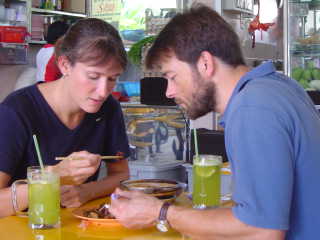 We ate lunch at a local “hawker stall”, bought a couple of essential items then took a taxi out to Mount Faber. Ed and Tim know of each other from the HAC in London but Ed, his wife, Jo, and their two lovely little daughters currently live in Singapore and had invited us to their home for tea. We enjoyed a fun and relaxing afternoon with them (and Jo’s sister, Kat, who is visiting en route to Australia) drinking tea and eating freshly baked cup cakes before taking a dip in their pool. We and Alana kept Paula and Stu (both Welsh) company amongst a few English supporters as they watched the England-Wales football match at a local stylish bar; sadly for Stu and Paula Wales lost. Day 159 Sunday 10th OctoberSingaporeInvited by Henry from RCL we attended the Mount Carmel Presbyterian Bible Church this morning – an hour and a half service in a modern air-conditioned church building. The preacher was excellent; he had left his work in the church a few years ago to work as an insurance clerk then eventually set up a business training professional speakers. The leader of the service encouraged the congregation to sing the songs of worship as energetically as possible accompanied by a pianist and band, the words were displayed on a screen and even had pictures to illustrate the messages. We did not recognise any of the songs but they were easy to follow. www.carmel.com.sg We were the only Caucasians there and, just in case we had not been spotted, we had to raise our hands to show that we were attending for the first time, for which we received a round of applause! We were also welcomed as we drank soybean milk after the service and were given a book and a CD rom about Jesus. Henry, his wife, Evelyn, sister-in-law Violette, and daughter Sarah, took us for lunch to a large hawker centre where we ate “steamed chicken”, one of Singapore’s most well-known Hainanese dishes (the rice is cooked in the stock which is then drained and the stock served in a separate dish). The strips of moist chicken are served over the rice with small dishes of ginger chilli paste and soy sauce to add interest. Dessert was peanuts cooked in liquid with soft rice balls stuffed with different nut pastes floating in it. 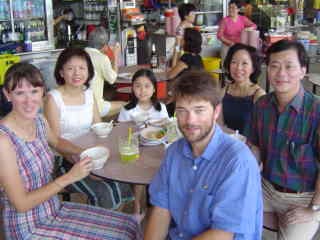 Food centres, colloquially known as hawker centres because before they were organised by the government small stalls used to set up on the streets, are areas with food stalls and fixed tables and chairs at which to sit and eat a selection of food from the stalls. The stalls are graded by the government for their level of hygiene and the tables are regularly cleaned by teams of people who sort and clean the plates and cutlery. Most housing areas have a hawker centre nearby as do office areas so it is easy to get good, interesting and cheap food (most dishes are $2 or $3 Singapore which is about £1 sterling) if you know where to go and are happy to eat under cover but outside in a non-ac area. 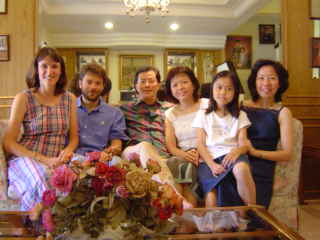 Henry's family home has displays of English tea pots, toys, ornaments and pictures demonstrating how much he enjoyed his time in England. After a good lunch we just ate soup and toast for supper as we chatted to Stu as he got ready for work on Monday and to Paula about her travels. Day 160 Monday 11th OctoberSingaporeAfter spending the morning travelling to and from the LTA office (Land Transport Authority) by bus we worked at the RCL office for the afternoon, trying to arrange shipping to Australia. www.lta.gov.sg All cars in Singapore have a device fitted on the dashboard that automatically debits the drivers cash card when he/she drives into a zone for which payment is due. As a visitor we were told we would have to rent one of these devices at S$5 a day plus pay whatever costs were due if we drove under an ERP gantry (Electonic Road Pricing) into a payable zone. The LTA department manager agreed that we could qualify for exemption status, which means that we do not have to rent a device but that each time we drive under a gantry during operating hours we will automatically be fined S$70 for the day. If we return to his office before we leave Singapore these fines will be reduced to a flat charge of S$10 per day we enter a payable zone. As we intend to drive in the zones as little as possible this system seems to be the most economical for us. Given the costs of and limitations on driving in Singapore it is amazing that so many people still do. Not only are there plenty of shiny (all cars here are gleaming) Japanese cars but we have also seen many Mercedes, some Jaguars and even a Rolls Royce. There is a small quota for classic cars that are allowed to drive on the road for not more that 28 days per year for the purposes of showing, servicing etc. We have seen a couple of vintage Minis, a Porsche and a VW Beetle. Buying a new four door family saloon car will cost on average S$120,000 (£40,000) and in order to drive a car one must have a COE – that is a Certificate of Entitlement that limits the number of cars on the road in each class and must be bid for as the price is not fixed. The COE lasts for ten years and can be extended but the cost of the COE and road tax rises exponentially for each year beyond ten years making it prohibitively expensive to keep a car beyond that so most are scrapped or sold overseas for parts. Other costs include a registration fee plus an additional registration fee of 140% of open market value, road tax, congestion charge, insurance and petrol. Because petrol is cheaper across the causeway in Malaysia the law states that tanks must be at least ¾ full, but we believe that they are only checked when crossing into Malaysia. As our car is imported temporarily on a Carnet de Passage we have exemption through the AA from COE and we will not be filling the tank to ¾ because it must be almost empty for sea passage. Customs replied late afternoon that because the car is containerised they must attend the unstuffing and stamp our carnet so Simon from RCL will take them and us to the trucking company warehouse tomorrow morning to retrieve Florence. At this stage we do not know how much the Customs officers will charge but we know they charge per half hour of their time away from the office. Ben Heyhoe-Flint, also HAC, has signed us in as his guests at the historic Singapore Cricket Club for the next couple of weeks and we met him there for a drink and supper along with Stu and Paula. 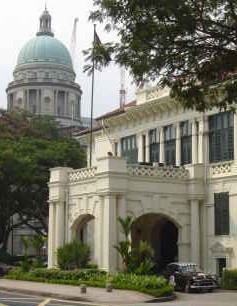 The Cricket Club was built in 1884 for the expat community and overlooks the Padang – a city centre playing field area that has hosted cricket events since the 1830’s and is flanked by impressive colonial buildings. Day 161Tuesday 12th OctoberSingaporeThe Customs people were friendly and efficient, having confirmed that the chassis and engine numbers on the car were the same as those on the Carnet de Passage they stamped it, completed the necessary paperwork then shook our hands and left after less than 20 minutes. It was surprisingly simple after the complicated procedures involved in dealing with Customs in India and Egypt. 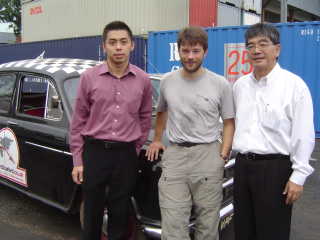 Simon (RCL), John (Allied Container Services) and Tim with Florence, just out of the container. The trucking company, Allied Container Services, charged us for transporting the container out of the port at cost so we paid $125 including port costs and tax, which is less than the commercial rate, thanks to RCL. As we had collected the customs officers from their office rather than paying for a taxi their fees were $40 – this fee could have been much higher. We parked at the RCL office so that the staff could see the car that their company had shipped to Singapore and went out for lunch at a nearby street stall with Henry, Simon and Thomas, the sales manager. Many of Singapore’s Chinese community are originally from the Southern provinces of China so are Hokkien or Hakka and the food reflects their roots. One of the best known Hakka dishes is yong tau foo, bean curd stuffed with minced meat; we ate this with noodles and stock prepared at a stall run by a cheerful animated man who was determined that we enjoy the food and enthusiastically shook our hands as we left. We had briefly met Richard Holloway at the Cricket Club last night and it transpired that he and Tim had mutual friends in London. He e-mailed this afternoon and invited us to supper with him and his wife, Sam, who have been living in Singapore for about ten years. Sam helped set up a group of English schools called Eton House and the Principal has invited us to visit – unfortunately this week is half-term and, because of the uncertainty of shipping dates we are not able to commit to next week. We ate stew and dumplings, a Jamie Oliver recipe, in their garden and really enjoyed chatting with them about their life as expats. Day 162 Wednesday 13th OctoberSingaporeUp at 5am this morning because we had been told that by 6.15am all of the groups practising Tai Chi in Botanic Gardens would have finished. Clearly the man at the information office has not tried going to the Botanic Gardens before sunrise! Paula and we walked from one end of the Gardens to the other and by 6.30am we were hot, dripping in sweat and had almost given up when a woman told us that we should join the Luk Tung Kuen class that would begin at 6.40am around the bandstand at the top of the rise just next to us. 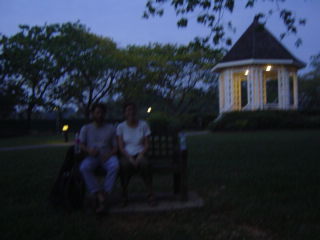 She enthused about the practise and introduced us to the instructor who explained some of the basics. We felt that as we were already dripping from our walk the length of the gardens we had warmed up sufficiently to join the forty or so people gathering in two loose lines along the path for their forty minutes daily exercise. Mainly stretches and slow repetitive movements, sometimes punching the air (always with fists held with thumbs inside) or pushing arms backwards (with fingers outstretched), it gave us a good workout and left us feeling invigorated and surprised at how tired our legs were. The class, like the Thai Chi, Fan Thai Chi and dance exercise classes that were taking place as we walked back to the car park, was free. The instructor is a Managing Director of a company who gives up his time every morning for the benefit of his fellow citizens. He was teaching an elderly couple after our class. By 7.30am the Botanic Gardens were full of people walking, running or in exercise groups, clearly arriving before dawn, as we did, is not the done thing. It is a lovely place to wander, well laid out with lawns, a variety of plants including orchids for which it has a special programme, and even primary rain forest. The Garden was created in the 1860’s (the original one created in 1822 was on Government Hill nearer the city centre) and is currently undergoing some improvement work so some areas like the swan lake can only be peaked at through special holes in the fence. After a well-deserved breakfast at the flat we found our way, via a short “detour”, to Harbourfront Place, previously the World Trade Centre. The cable cars across to Sentosa Island and up to Mount Faber pass through the two impressive modern 13 storey glass office blocks linked to a smart shopping centre. Parking is efficient and reasonable value if one knows the system and has the appropriate cards; sadly we do not. After quizzing a security guard we worked out that we could either buy a “cash card” for S$20 or a book of parking tickets for S$10 but as we only needed S$1 worth of tickets to park for an hour on the other side of the dual carriageway from the offices (where one is not able to buy tickets) we persuaded another car park user to sell us S$1.50 worth of parking tickets. The system for parking, like the system for road users, assumes knowledge and is not geared towards short-term visitors so is frustrating and time-consuming for visitors like us. We were, therefore, a little late for our meeting with Vivian and Tang at P&O Nedlloyd to thank them for offering to ship Florence from Singapore to Freemantle free of freight and to discuss the details. We also met David of P&O Nedlloyd Logistics who later confirmed that they would be able to prepare the car for shipping free of charge. Fantastic news! Apparently, on the run up to Christmas finding spare capacity on ships to Australia is even more difficult than the rest of the year and prices have increased by almost five times since last year with international demand for new ships outstripping supply. Now is not a good time to be trying to arrange economical sea transport so we are really grateful for the support of RCL to get us to Singapore and the offer of support from P&O Nedlloyd to take Florence from Singapore to Australia. www.ponl.com www.ponlogistics.com Unfortunately, P&O Nedlloyd are not able to allow us to travel on the ship so we are trying to arrange flights from Singapore to Perth. As we have a few people we would like to meet and a couple of schools to visit in Jakarta we will try to stopover in Indonesia en route. We were lunch guests of Oxford Brookes alumnus, Colin Miles, at the Rotary Club of Singapore (District 3310) who met at The Meritus Mandarin Hotel on Orchard Road. We made a punchy three-minute presentation then enjoyed the steamed chicken lunch as we listened to the main speaker tell us about the challenges of doing business in China. It seems that Singapore “Straits born Chinese” find it no easier to do business in China than British or European business people. www.rotary.org.sg Stu flew to India for a few days business this afternoon and let us stay in his flat, really generous of him as he hardly knew us before we arrived. Paula, Stu’s friend from Wales, leaves tomorrow for Hong Kong but was keen to visit the night safari before she left. It was well worth the long trek out there by MRT (Mass Rapid Transit, an efficient underground train service) and bus with a quick stop for supper at a hawker centre in the suburb of Ang Mo Kio. A conducted tram took us around the hundred-acre jungle site and we walked a trail to get even closer to animals ranging from lions, golden cats, leopards and tigers to fruit bats, flying squirrels, porcupines and otters. Over a hundred species can be viewed with subtle lighting that does not disturb their night activities and with ditches or mirrored glass rather than fences in the darkness there appeared to be no barriers between the animals and us. At S$24 per person it is not cheap (and they do not give YHA discounts as the book states, only KFC – yes, Kentucky Fried Chicken – discounts!) but it really was a superb experience. www.nightsafari.com.sg Day 163 Thursday 14th OctoberSingaporeTim is suffering from a stuffy cold so, as we had a few people to call and e-mail, we did not go far today. We ate lunch at a hawker centre by the river, just around the corner from where we are staying: there is so much variety that we could easily eat a different dish every day we are here. Today we ate Cantonese style food; Tim ate noodles with chicken and Joanne ate “congee” – rice porridge with shredded chicken, chopped spring onions and crisp roasted onions - and we shared some pork dumplings. The choice of drinks is interesting too – soybean milk, barley water, jelly drink and sugar cane juice are popular as is ginger tea and chrysanthemum tea. Ang Choon Kiat, a Rotarian and travel and Land Rover enthusiast we had met at lunch on Wednesday invited us to join him, his wife, Jane, and family for a “simple family supper” at his home so that he could help us print some A4 photos of India for our presentations. Jane and Ang are both architects and live in an unusual modern open plan home that is designed to create outside/indoor rooms. The path to the front door is made of large square slabs over pools of tropical fish and most rooms are open to the garden. The large slatted doors can be closed at night, as can the fins/louvers at the edge of the roof that can be automatically adjusted to provide shade/ventilation or shelter from the rain. We all sat on stools around a circular table and shared the food in the centre that we ate with rice using chopsticks or spoons: a tender chicken cooked in spiced stock inside a plastic bag and tin foil, a whole fish, cooked watercress, soup and pork spare ribs. We finished with particularly good vanilla ice cream then drank green tea (freshly brought back from China) for the rest of the evening. Ang and Jane are among the most well travelled of anyone we have met since we left England nearly six months ago. They showed us a selection of photos of their Peugot 204 in various countries on their drive from London to Madras, India, in 1971 as well as sketch drawings illustrating how they had converted it into a “camping car” with seats that folded down into a double bed, curtains at the windows and a box in the boot with cooking stove and storage space for food. From Madras they shipped to Singapore. From here they have continued to travel, mostly overland and usually with their three children, from a winter camper van journey through the USA National Parks to camping in Tasmania. Next year they will ship their Landrover to South America where they are planning to join other 4wd owners in a drive through Patagonia. If Joanne had not fallen asleep while perusing an atlas while Tim and Ang printed the photos she might have been able to make more of the opportunity to look at the touring atlas of Australia, Lonely Planet guide to NZ and other useful books that Ang got out for us. We did not leave until nearly midnight because the photos took so long to print but we were really pleased to have got them done and to have spent an evening with such lovely interesting people. Tim was still fairly congested so Jane gave him some cold pills to take before going to bed – we were surprised to see that they are from “Boots”. Day 164 Friday 15th OctoberSingaporeTim’s Mum used to teach at the Tanglin School, which was established to provide a British education in 1925, so we had been invited by the head of school, Ronald Stones OBE, to visit and meet some of the children. Children gathered at the main entrance to the school waved and cheered as we pulled up and the head of school, head of senior school, David Woods, and other teachers greeted us enthusiastically as flyers of the British flag who represent something of Britain. We spent some time parked at the entrance as different groups of children took it in turns to gather around Florence and talk to us about our journey. 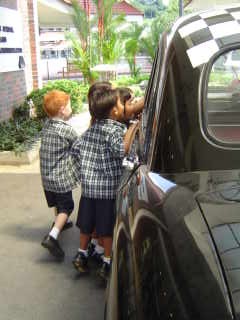 David took us on a tour of the school from the primary school where open plan classrooms share activity areas including a computer area equipped with computers in front of tiny chairs, through the middle school and the sixth form. Ronald treated us to cappuccino and the best chocolate brownie either of us has eaten for a long time in the stylish, colourful and friendly staff room before we left, waved off by a group of the youngest children at the school who had sat looking at the world map on the car while Joanne explained what we are doing and then took it in turns to look inside the car. 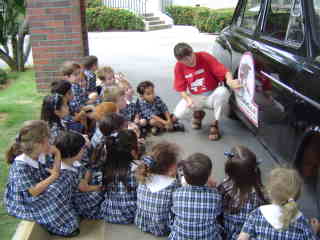 We really enjoyed our visit to what we felt was a most impressive school offering a rounded British education to expat children and we are told that the school appreciated our visit too – it was something different at the end of term. 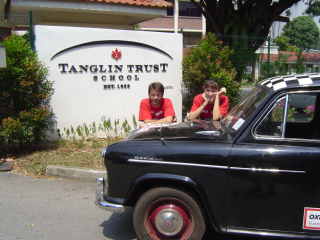 There are several schools in Singapore catering to different expat communities including Dutch and German schools. Other private schools also offer a British education but the Tanglin Trust School operates as a trust and does not make a profit. www.tts.edu.sg We were interested to see that security was high with armed Gurkha’s guarding the premises, as with many other British institutions here. The school also regularly practises evacuation procedures. This evening we walked from Valley Park along the river past renovated wharfs and warehouses, many now smart shopping, restaurant and hotel complexes, to Clarke’s Quay where we ate chicken satay with rice cake (ketupat) and laksa (rice noodles in a chilli coconut soup with beansprouts, prawns and rice flour noodles at a small food court. The Singapore History Museum opposite at Riverside Point is being refurbished; we visited the small temporary exhibition free of charge that illustrates in brief the history of the island before walking back along the other side of the river. Day 165 Saturday 16th OctoberSingaporeTraffic charges do not apply at the weekend so we explored colonial Singapore and Chinatown in Florence this afternoon stopping by the Cricket Club overlooking the Padang where men in whites were playing cricket; 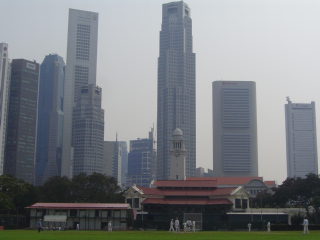 a quick stop at the famous Raffles hotel; 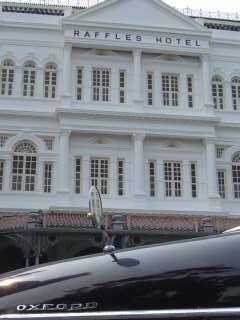 past St Andrews Cathedral; 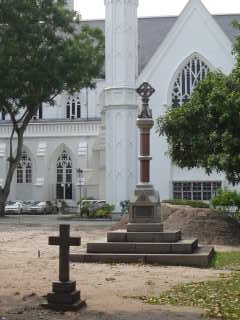 along the wide streets of the towering CBD (central business district); 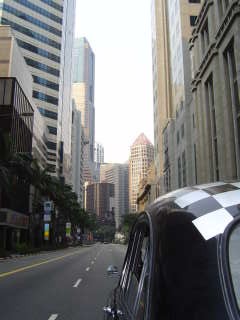 and through the lively colourful streets of China town. 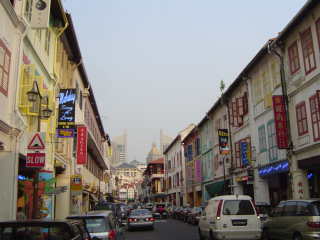 This evening we made a presentation in the pub at the British Club then ate fish and chips wrapped in the British Club newspaper and steak and kidney pie and chips while we joined in (very badly) with the pub quiz. 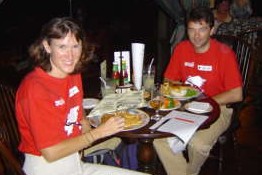 We were made very welcome and chatted to several people who were enthusiastic about our adventure. 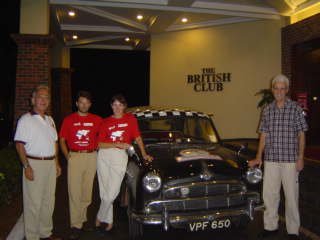 A woman at the Club told us that her son had excitedly rushed in moments earlier to tell her that the special car that had visited the school was outside – he had insisted that the family watch Channel News Asia at 6am that morning because that is when the TV cameraman who filmed us at the school had said it might be on TV. He was, said his Mum, much more excited about the visit of Florence to the school than he had been about the visit the week earlier of Prince Edward. Apparently, the children were disappointed that he was not wearing a crown. Day 166 Sunday 17th OctoberSingaporeThe food court at Tiong Bahru, a nearby residential area, is being redeveloped and is temporarily established a little way away – the biggest we have been to yet it was packed at lunchtime and offered a vast selection of foods from about 200 stalls. 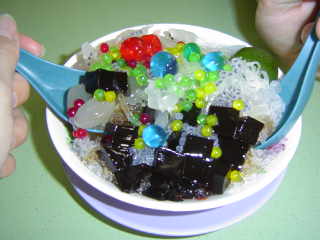 After duck with rice and “carrot cake” (which does not resemble the orange vegetable carrot in any way) we shared a most unusual but popular desert of multicoloured jelly and fruit called Blooming flower. We missed the heaviest storm and downpour but still got soaked on our way back to Valley Park, though with the temperature only just below 30 it was pleasant to walk in the rain. The monsoon has now caught us up and after a few sunny days when we first arrived most days are now overcast with frequent storms and heavy rain. It does mean that though still humid it is not as hot and if one carries an umbrella walking is more pleasant than in the heat. Forty-five years ago Tim’s Mum worked for two years as Governess to the children of the boss of Sime Darby and lived with them on Nassim Road, very close to the Botanic Gardens. The house has now been knocked down and the site redeveloped but Paul, the son in law of the people who own the site, invited us in and showed us around the large modern luxurious house. 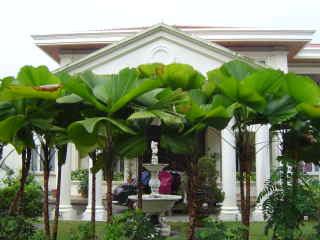 Paul kindly invited us to the Full Moon party to be held next week marking a month after the birth of his son. According to Chinese tradition mothers do not leave the home (or bathe) for a month after the birth then a party is held to introduce the baby to family and friends. If we are still here in a week’s time we will happily join them. Nassim Road, Chatsworth Avenue and Tanglin Road have some good examples of “black and white” mansions set in spacious tropical grounds and built around the 1920’s for senior business and military personnel and colonial administrators. 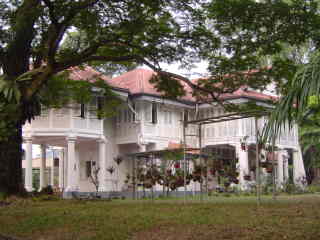 3 Chatsworth Avenue They were built with grand covered entrances, shaded verandas, high ceilings and black and white bamboo blinds to cope with the tropical climate without air conditioning. 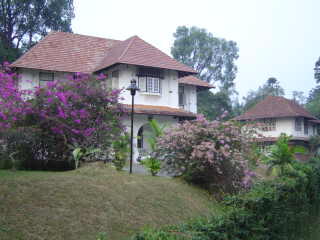 4 Bishopsgate Many of the large homes have covered walkways to servants’ houses in the grounds. 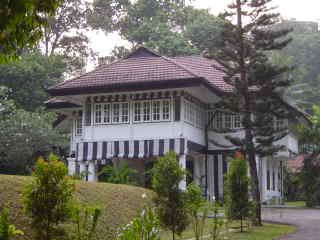 The road names Orchard Road and Orange Grove Road show how much greener the garden city must have been only a few years ago; Tim’s Mum would be amazed to see the changes since she left. Singapore is famous for Chili Crab created in 1956 by a Mrs Lim who made up the now famous sauce of tomato, chilli and egg in which the crab is served roughly chopped up. It is probably the messiest meal one could concoct and Stu and his friend, Elana, warned us not to wear our best clothes when we joined them at the East Coast Seafood Centre where we tucked in with our fingers to Chili Crab, Black Pepper Crab and crispy unshelled large prawns and used sweet bread buns to mop up the sauce. 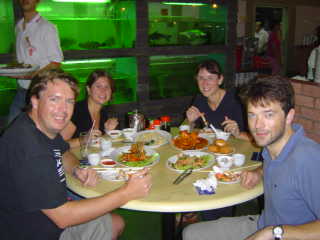 It was a really fun messy meal eaten at the sea front. Day 167 Monday 18th OctoberSingaporeThe British Red Cross began working in Singapore on 30th Sept 1949; when Singapore became an independent country in 1973 an Act of Parliament incorporated The Singapore Red Cross. This afternoon we met with Lim Theam Poh and Alex Joel Lim in the International Services Division of the Singapore Red Cross and they explained how the organisation operates both in Singapore and overseas as part of the International Federation of Red Cross and Red Crescent Societies. The need for many of the services usually provided by the national Red Cross or Red Crescent society is almost negated here because almost everyone has private health insurance and the state or specific charities (such as cancer or dialysis) provides help for those who still need it. The state took over responsibility for providing blood bank services, traditionally a Red Cross role, in the light of AIDS leaving the Singapore Red Cross to recruit donors. Singapore imports almost everything including food and water so, though it is not at risk from natural disasters, it is vulnerable to manmade disasters such as terrorism or aircraft crashes as well as manmade/natural disasters such as SARS or Asian bird flu. For that reason the government is well prepared for potential disasters. Singapore Red Cross medical volunteers would care for less serious casualties in a disaster situation leaving the rest of the disaster relief effort to the state which would mobilise the services and armed forces. As with all Red Cross and Red Crescent organisations we have visited teaching First Aid is a key role; here they are aiming to have an equipped first aider in each home by 2010. Internationally, as well as supporting the work of the International Federation and Committee on projects such as disaster relief after the earthquake in Gujarat, the Singapore Red Cross regularly sends volunteers to support the work of the Indonesian Red Cross, for example, running small clinics for people who have no access to medical facilities. 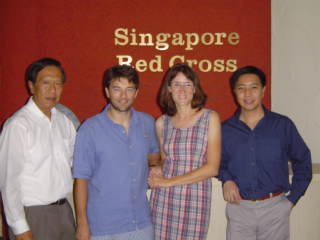 Having met with Lim and Alex we are now in a position to mention the Singapore Red Cross if given a chance during our interview on Channel News Asia tomorrow morning. Though we can only fundraise for the British Red Cross in Britain we encourage people to support the work of their national Red Cross or Red Crescent organisation. Stuart, who we are staying with in Singapore, agreed to advise us about our potential purchase of a second notebook computer so met us at the Funan Centre, a shopping mall dedicated to computers. Singapore is a shopping mall lovers dream destination but not if one is on a budget. However, it is a good place to buy IT and if we claim the tax back we should be able to get a laptop at a good price. We have a four year-old Sony VAIO, near top of the range when new but it does not have a network card or a CD writer, both of which are standard on new computers now. This means that we cannot take advantage of WIFI (wireless free) or broadband Internet connections when available and we cannot back up our data to CD rom. Our external CD writer is still not working. Furthermore, with the amount of work that we need to do to keep up to date with the diary, photos, accounts, e-mails, website and so on we need two laptops. We found a good offer at Funan mall but have not yet decided; there is still a faint hope that a company might sponsor us or we might be able to find a better price elsewhere but we will have to decide soon. Supper at Victoria food centre which was a bit scruffy and disappointing despite the recommendation in the Lonely Planet guide, then a walk through the totally renovated Raffles Hotel, theatre and shopping arcade with its selection of top designer stores. 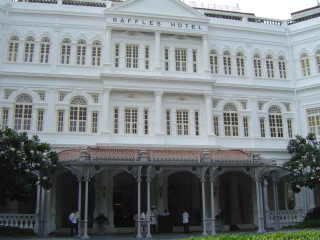 The hotel still exudes colonial grandeur and its beautiful white façade with sweeping drive to the front entrance gives an impression of how Singapore was in its heyday when Somerset Maugham could sit on the veranda looking out to the sea. Now tall modern buildings have been built on the reclaimed land in front of the hotel so one must look inside to breathe a whiff of history. We were amused to see that even the top hotel in town proudly displays its “A” government issued hygiene rating, stuck on a pillar in the Tiffin Room, in the same way that the stalls do in the food courts in the housing estates. The setting is lovely and it was tempting to book a table for high tea at $35 each but we might save that big treat until later in the week. We were not tempted by a “Singapore Sling” at $16 each – a very pink fancy drink that, we are told, is very sweet and mixed better elsewhere in town. Bus back to Valley Park – the public transport system is efficient, frequent air-con buses travelling most routes but there are no maps of bus routes so without asking people or phoning up the transport help desk (which costs more than the bus fare) there appears to be no way of working out which bus we need to take from where. Stuart has a new 2004 street directory and bus guide but on the two occasions we have called the helpdesk because we could not work out the route it turned out that the bus numbers had changed since the book was published. Most frustrating to those who do not have bus routes already programmed into their pocket computer or know the routes by heart. Day 168 Tuesday 19th OctoberSingaporeThis mornings Prime Time Morning show on Channel News Asia was our first live studio TV interview. Footage of our visit to the Tanglin school on Friday and many of our photos were broadcast as Suzanne Jung and Richard Lui interviewed us for ten minutes about our journey. Talking to them in the virtual studio – sofas and table in front of a blue backdrop on which a skyline of Singapore is imposed on the TV – was fun as they made us feel relaxed and asked questions to which we could give amusing answers. 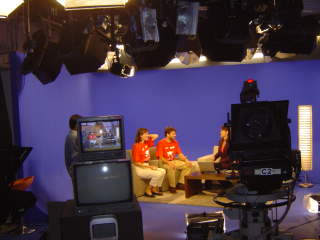 Everyone seemed to think it went well and they were happy for us to hang around afterwards to watch the news being broadcast and see how the studio operates. www.channelnewsasia.com/ptm After a little time spent finding a company to help us clean the car and some more research into our options for onward travel from Singapore we headed off to Fort Canning Park to visit the Battlebox, the former Second World War British Military Headquarters and communications centre. A series of underground rooms, when closed it protected those inside against bomb and gas attack. The audio tour recreates the scene and the atmosphere in the headquarters in the few days up to the 15th February 1942 when the British surrendered Singapore to the Japanese. It was raining as we left the bunker so we stopped for a cup of tea in one of the former barrack buildings now stylishly renovated and recently opened as a club. The walk down through the park led us to Hill streets where we crossed the river and walked down to China town. 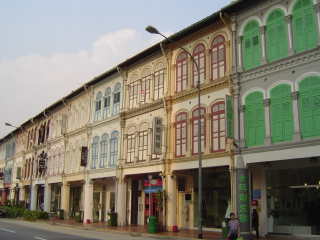 We ate dinner in a small converted shop house restaurant on Kreta Ayer Road called Xin Min Vegetarian Food Court. We were surprised to see a section of “vegetarian chicken” dishes on the menu and thought that perhaps it should have been translated as “vegetable chicken” until it was explained to us that the “chicken” was tofu cooked to resemble chicken. Our meal of dry chilli chicken, special fried rice with bits of “pork”, spring rolls, and green vegetable was excellent and there were no worries about finding bits of gristle or bone in the chicken dish. 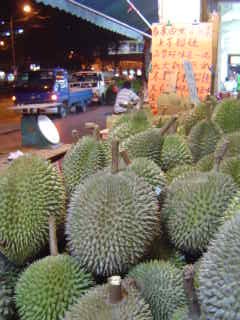 Durian fruit stall Walked back past Chinese housing estates, shops selling all sorts of Chinese produce and stalls selling durian fruit (some think it is delicious but all agree that the smell is dreadful!) then past old warehouses and stylish modern restaurant areas along the river to Valley Park. Day 169 Wednesday 20th OctoberSingaporeSpent six hours cleaning the car inside and out with the help of the team at Bronze Car Man Pte Ltd www.bronzecarman.com at the Toh Guan Centre. We are told that, in order to pass the stringent checks of Australian quarantine the car should be as clean as new – challenging with a fifty-year-old car that has travelled across the desert roads of North Africa and through the dust and monsoon mud of India. 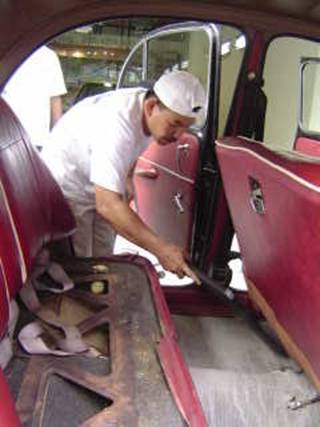 The team at Bronze Carman were most helpful, cleaning, polishing and doing a bit of vacuuming but let us get stuck in inside the engine 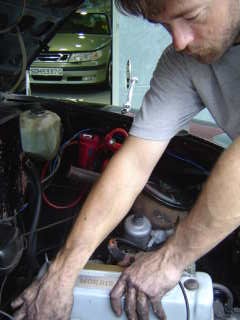 and under the carpet and seats inside the car. 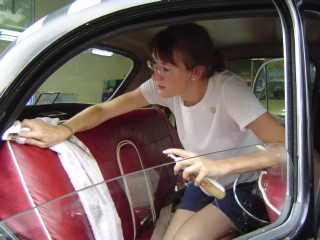 Their selection of professional cleaning agents for leather, removing oil and grease, cleaning windows and polishing chrome and piles of clean white cloths and small towels helped us make Florence look shinier than she has looked for a long time. 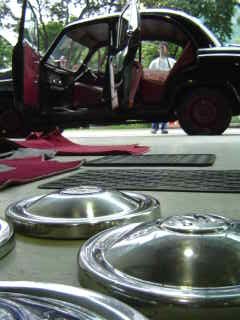 Most cars in Singapore are under five years old and cleaned every day so cleaning a car here is a relatively clean process as no serious mud or grime has had a chance to accumulate. Bronze Carman is a unit in a block of car parts and servicing businesses – they hose and soap the cars just outside then bring them in to the super clean inside area for polishing etc. 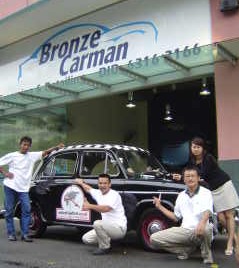 The reception and customer waiting area resembles a smart hairdressers with cream leather sofas, glass topped coffee table, flowers, leather waste bin, magazines and newspapers, coffee machine and bottles of car cleaning fluids neatly positioned on glass display shelves around the walls. We took a break for a quick lunch of noodles and chicken in soya sauce and a glass of fruit juice upstairs in the centre food court – particularly good value. No-one in the centre was able to jack up the car and clean underneath (they either clean cars or they jack them up to repair them but cleaning underneath would be too dirty) so Joanne and Russell of Bronze Carman found a garage that will hopefully lift the car and clean underneath. We will go there tomorrow morning before stuffing the car in the afternoon. Florence looked super shiny for her appointment with the British High Commissioner this evening. 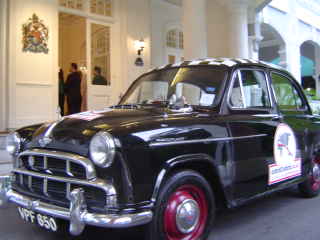 She was parked in front of the steps at the front door of the Residence, an elegant house on Nassim Road that is one hundred years old this year, so that everyone attending the Lloyds of London reception had to walk past her when they arrived. 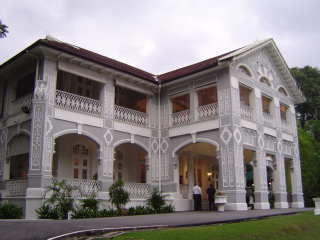 The British High Commissioner, Alan Collins CMG, admired Florence, though felt a little cramped in the drivers seat, and commended all at the reception to look at her on their way out. 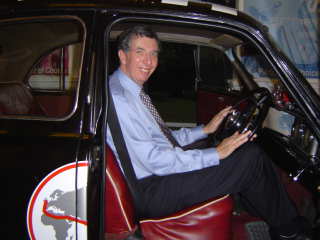 The Commissioner welcomed the Lloyds of London representatives and guests and introduced, not dancing girls or singers to entertain them but “two young people” who are driving across the world in their fifty year old Morris Oxford. As most people in the ballroom were insurance experts he asked how one insures a fifty-year-old car to drive across the world. We wrapped up our five minute talk by explaining that BBC Radio Four’s “Moneybox” insurance experts did not know the answer and it turned out that we cannot take out one policy to insure our car across the world, instead we bought insurance for a vintage car in Europe and we buy insurance as we cross into each new country. Day 170 Thursday 21st OctoberSingaporeWe are still in Singapore, despite our efforts to find a sponsored or economical route from here to Australia. Apparently flights from Singapore are expensive and often full and most of the airlines we have spoken to have already spent their sponsorship budget. Another option is to travel by ferry to Bantam Island, Indonesia and fly from there internally to Jakarta then on to Perth; if we do that we must add in the cost of visas - US$10 for three days or US$25 for up to thirty days. We’re looking into that option. Florence was stuffed into the container today and is expected to depart Singapore on 24th October for the six day crossing to Fremantle. The quarantine rules for entry into Australia are apparently very tight and we were keen to lift the car up and thoroughly clean underneath before stuffing but, we discovered after speaking to various people including the Land Transport Authority and the AA, and calling in to many garages, no-one steam cleans or cleans underneath cars in Singapore. We were told that to do so a garage must have a licence but no one was able to tell us who issues or who holds a licence. We eventually had to admit a frustrated defeat and stuff the car into the container in the hope that our cleaning by hand yesterday will be sufficient. 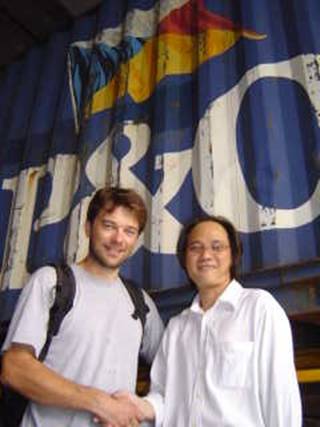 Alan from P and O Nedlloyd Logistics escorted us through the stuffing process – photo passes issued to us to enter the port, into the customs office where the carnet was stamped, then to the warehouse at the edge of which containers are lined up already on trailers ready to be towed off as soon as they are stuffed. They even have ramps to drive up into the container rather than little toppling blocks that we have encountered elsewhere. We seemed to provide a great source of interest, perhaps the men working in the warehouse had seen us on TV too, and plenty of photos were taken of the stuffing procedure and us. 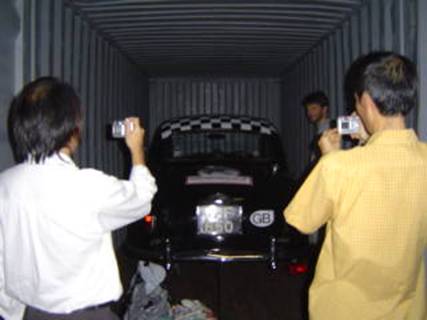 No wood is allowed through Australian quarantine checks so extra lashings were tied to the wheels and suspension instead of using wooden blocks around the wheels. 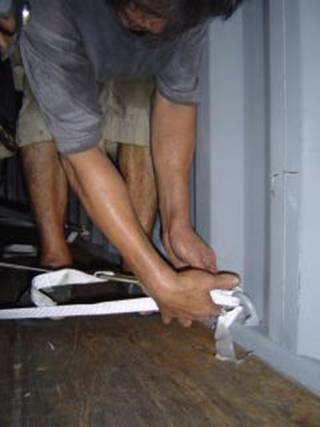 The same procedure took a full day both in Egypt and India; here we were finished only an hour after we arrived at the port…and unlike Egypt and India we paid no bribes. 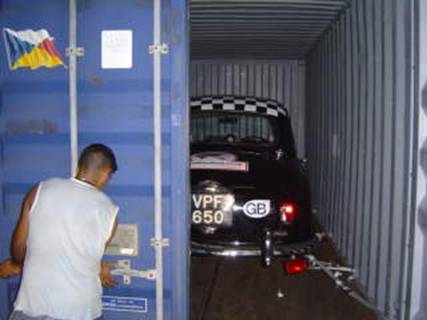 Customs did not even look at the car but that might have been because we were recognised by one of the Customs officers – he thought initially that Tim had been to the office previously then realised that he had seen us on yesterday’s breakfast TV show and proceeded to recount our comments about which of us is the best driver (“Tim is not a good passenger but is a good driver and Joanne is a good navigator”) and other answers we gave in the interview which he thought was particularly good. Without the car again we took a taxi to the Media Corp Studios where we had been for our interview yesterday morning, this time we met with Colin and his wife, Carol, to watch “Singapore Idol” being filmed live. 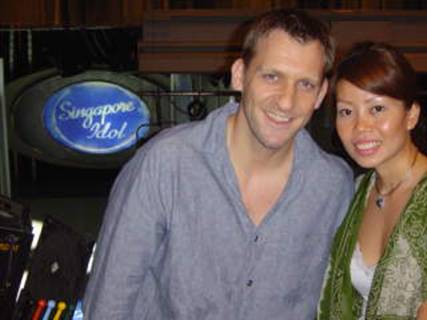 “Idol” is a successful TV show with thirty countries now operating the franchise. www.starhub.com/idol The majority of the audience were screaming teenagers or families of the seven wannabe pop stars competing to win a recording contract but it was great fun to be part of the studio audience as they broadcast live. Colin is an Oxford Brookes alumni who is in touch with several other Singapore based OB alumni, two of who, Tong and Kenneth, met us for a drink afterwards in a wine bar converted from an ornate traditional shop house on Emerald Hill. 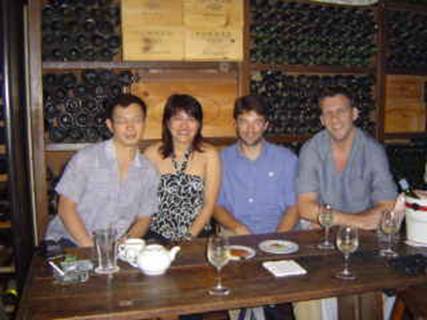
Day 171 Friday 22nd OctoberSingaporeA visit to the largest shopping mall in Singapore this morning, Suntec City, that has, or does when it is working, the largest fountain in the world at its centre. The centre represents the palm of a hand and the four office towers represent fingers, the conference centre the thumb; apparently the palm of the left hand signifies wealth hence the fountain being called the Fountain of Wealth. Stu works in one of the towers and met us for a coffee and shared his expertise with us about our potential purchase of a Dell notebook. Despite what we had read yesterday about next day delivery Dell keeps no stock here and it takes a minimum of five working days for delivery from Japan so we will not be able to buy a Dell computer here, perhaps in Australia. The walk back to the Singapore Red Cross office took us past the Esplanade and the striking new porcupine like domes of the theatre; 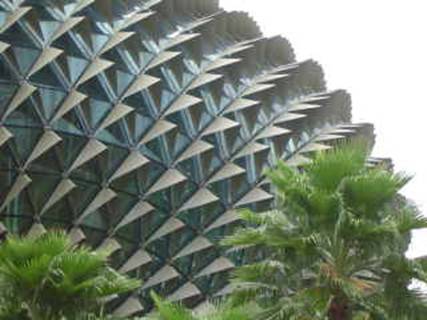 across the Padang in the centre of colonial Singapore; 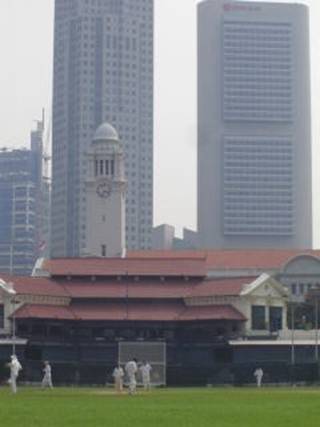 through Funan IT Mall; past the former police headquarters 1930’s building with its various coloured shutters on Hill Street; 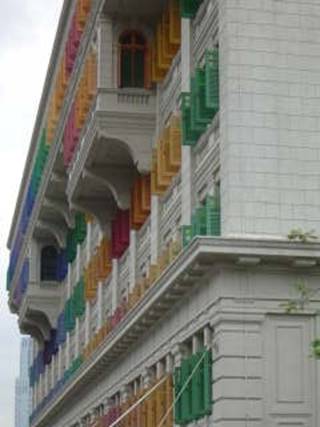 and up to Fort Canning Hill. Now a park with marked walkways and information boards the hill is a significant site in the history of Singapore. Archaeological finds confirm that the hill was the site of the palace of the king of the Malay kingdom in the 13th Century when the island was known as Temasek and a “Keramat” or holy place marks what is said to be the burial place of the last king. Two gates remain of the fort that stood on the levelled top of the hill from 1861-1926. The fort was built as a place of safety for the European residents in case the other people turned on them and the area was later used to build a barracks and military housing as well as an underground military headquarters and communication post. The gravestones from the first Christian cemetery on the island are now set in the wall of a garden in front of the building that was once the British Army barracks and is now a centre for performing arts. The area where the married quarters were built is now a reservoir. A lookout platform marks the site of the home of Sir Stamford Raffles with views across the town to the port and to Chinatown and the river and a spice garden pays tribute to the establishment by Raffles of the first Singapore Botanical Garden on this site. It was moved to its current larger site in the 1860’s. The British used the hill as a communications post from their first arrival in Singapore to after the Second World War. A flagstaff at the top of the hill signalled information to the townspeople, the traders and the port workers such as when a ship was due to arrive, what cargo was on board, whether it was to be quarantined, warnings of a fire in town and so on. 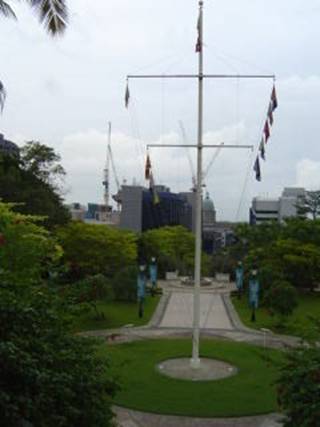 Nearby is a time ball, a large gold ball suspended vertically that used to be raised at 12.55pm and dropped at 1pm to ensure that everyone was on the correct time. 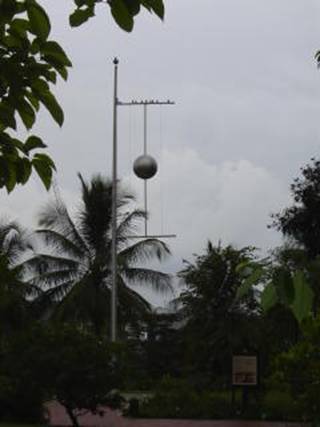 We called in at the Singapore Red Cross office on our way back to Valley Park and handed over S$200 donated by Russell Loh at Bronze Carman. This evening we met up with Ben, HAC, at an exhibition of paintings by an Indian artist, Girish, at an apartment on the eastern side of Singapore. Jo, Bens wife, was working late but joined us for a pizza at a restaurant on the beach on the East coast – a storm and huge downpour stopped us sitting on the sand but it was a fun place and really good to chat to Jo and Ben. Day 172 Saturday 23rd OctoberSingaporeDetermined to sort out our route from Singapore to Australia, Tim spent much time doing more research on the internet and by calling airlines and travel agents. With little success we decided to go and talk to STA travel on Orchard Road. Irritatingly, today is their 25th Anniversary and they are closed all day so we have still not made definite progress. We had been advised that travelling by ferry to Indonesia and flying from there to Australia would be cheaper but the prices quoted online actually make this a more expensive option than flying direct from Singapore. We have also looked into taking ferries from Singapore to Indonesia then flying from Indonesia to Darwin and travelling overland from Darwin to Perth but there is only one ferry that we could catch to get us to Indonesia which would not allow us enough time to travel overland in Australia and the cost of the flight to Darwin is almost as much as a flight direct to Perth from here. It is a shame because there used to be a ferry service from Bali to Darwin that would have meant we would not have to fly and we could have visited, although briefly, Indonesia but this is no longer operating. Bus to the Armenian Street branch of the Asian Civilisations Museum; the second part of the Museum was recently opened at Empress Place and houses a large exhibition of items representing all Asian Civilisations. 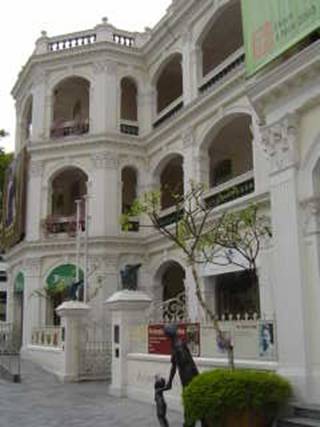 The Armenian Street branch is in a beautifully renovated boys school and houses an exhibition of Peranakan culture – the Peranakans are the descendents of Chinese merchants who settled in Malacca (Malaysia) and Singapore during the 18th Century and married local Malay women. They were typically wealthy merchants who felt that their status was above that of the later Chinese immigrants who were usually labourers or “coolies” on ships, were well educated and were later employed by the British in the Civil Service. They now make up a small proportion of the population but their traditions, culture and food, a mix of Malay and Chinese styles, is still popular. We have eaten much Peranakan style food during our stay in Singapore. 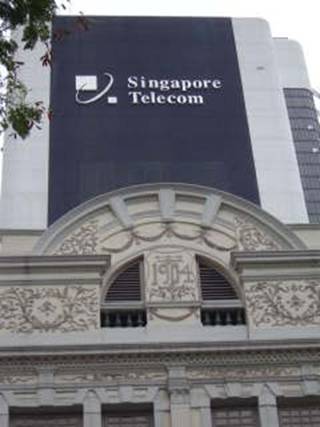 A walk through some of former colonial Singapore in search of a cup of tea (unsuccessfully) took us past the “Stamford Building”, an ornate building built in 1904 with smart shops on the ground floor and now dominated by the modern Singapore Telecom tower, then through Chijmes. 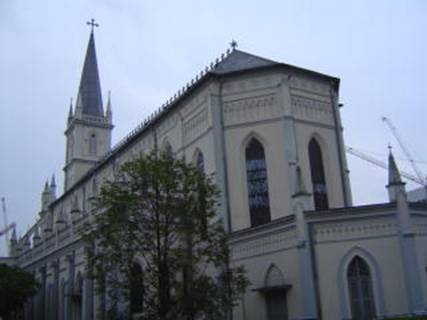 Chijmes was built in 1854 as the Convent of the Hold Infant Jesus where the sisters ran a women’s refuge, orphanage and school until 1983 when the convent was relocated and the buildings converted into a series of shops, bars and restaurants. 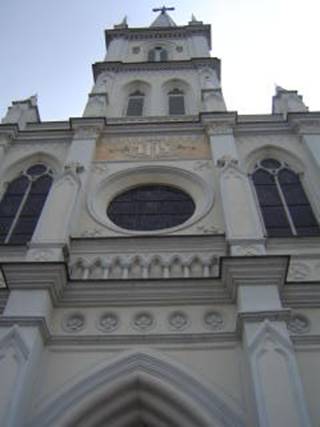 The main church building was being prepared for a wedding ceremony so was closed to visitors when we were there and the restaurants were gearing up for the evenings so it was not the place to sit in the cloisters for a cup of tea that we had hoped. We therefore bussed back for a cup of tea at home and had a lazy night in watching “The Life of Brian” while we ate a takeaway. Much of it was filmed in an area of Tunisia we had visited and Joanne had never watched the classic Monty Python film – hard to believe but true! Stu, our host, is now away for a few days and has kindly allowed us the continued use of his flat – we are probably his longest staying guests and, even though he says that he is happy for us to stay longer we are determined to have left by the time he returns! Day 173 Sunday 24th OctoberSingapore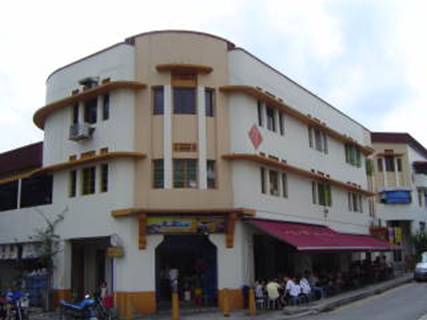 Tiong Bahru, a ten-minute walk from Valley Park, is one of the oldest suburban residential areas in Singapore and is noted for its low level Art-Deco style apartment blocks, it’s market, food court and bird-singing corner. 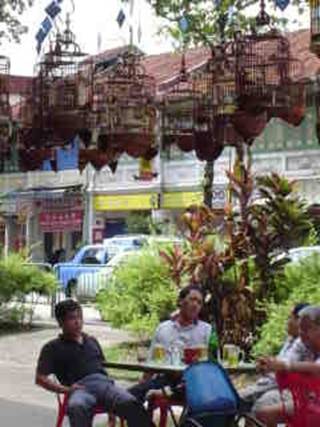 A traditional Chinese occupation, men gather on Sunday mornings and drink coffee or beer together while their tiny songbirds in ornate cages that are hooked to the roof sing. 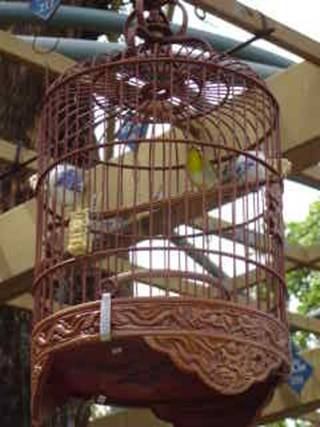 Sadly, the street corner is run-down and is at the end of a block that is due for renovation. The coffee on offer nearby was served in Carnation milk tins with loops of string to hold them so that the men could take them to their corner. There were all sorts of food on offer at the nearby food court - including frogs, squashed live in a tank ready for selection. 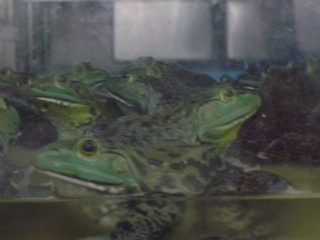 We drank coffee, strong and sweetened with condensed milk, and ate toast at a busy street corner café further along the road. We had hoped to try the traditional “kaya”, toast with egg and coconut, but we could not find anywhere that served it. Surprising as this was a local residential area, not a touristy area. Excellent lunch of roast pork Chinese style with rice and green tea at a street corner stall very close to Valley Park for S$3.50 each; apparently the place is famous for this dish and for rice noodles with shredded chicken, this was demonstrated by the number of smart people who regularly pulled up in BMW’s and Mercedes cars for lunch. Last Sunday we had met Paul, the son-in-law of the owners of the house that stands on the site of the house on Nassim Road where Tim’s Mum used to live, and he invited us to the Full Moon Party of his daughter this evening. Traditionally Chinese babies are introduced to family and friends a month after being born; for the first month they and their mothers do not leave the house (or bathe, though this is now often relaxed). The baby, Athena, (named after the Greek Goddess of wealth), dressed in a long white gown with mittens and bonnet, was introduced by his mother, Jana, to about forty guests over a casual buffet barbeque supper. The mother’s family is Indonesian while the father is Chinese so the traditions and foods of both cultures and modern Singapore were combined. In the centre of the table the cake was a Cindy doll with a large decorated cake skirt and on the sideboard were traditional Indonesian sweets – pyramid shaped cellophane wrapped “pulit inti” which is blue glutinous rice topped with dark brown shredded coconut and brown sugar; and “ang ku kueh, green bean paste in small red dome shapes. If for a boy they would have been pointed shapes. On the other side of the huge “diaper cake” present from the mothers sisters also on the sideboard – a cone made of nappies and decorated with bonnets, gloves, flowers and bottles – was a pile of red coloured hard boiled eggs from the Chinese tradition and symbolising new life. Athena did not seem much impressed with the tradition of rolling an egg around her face! For dessert we ate “onde”, another traditional food to eat at a Full Moon Party that consists of small white and pink glutinous rice balls in clear syrup. Each family was presented with a box as they left containing red eggs, pulit inti, ang ku kueh and a 15inch cake decorated in pink icing with a plastic baby on top and the words “Happy one month, Athena”. 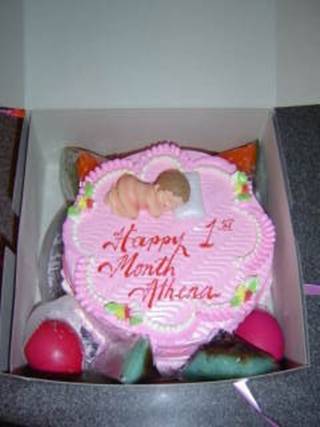 We’re looking forward to trying ours tomorrow, though it will be a challenge to eat all the cake before we leave and we will not be able to take it in to Australia. Perhaps we’ll freeze some and leave it for Stu. Day 174 Monday 25th October 2004Depart Singapore for AustraliaFlorence, our car, departed on a P and O Nedlloyd container ship yesterday bound for Fremantle. This morning we found and booked flights to Perth departing tonight! 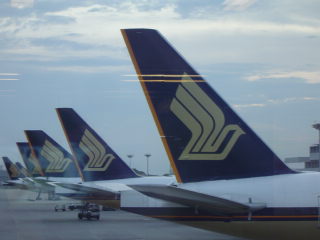 So after 16 busy and fun days in Singapore we are leaving tonight to begin the Australian leg of our journey. It has been an interesting stop in our journey, the shortest drive in any one country. Our car certainly stood out among the smart, new and perfectly polished status symbols driving around Singapore - there are a few classic cars but they are perfect too, not battered and a bit grubby like our characterful fifty year old Florence. We have had a great reception and have even been told by a Singaporean that it has been an honour to have had our car in his country. The Brits we have met, there are more here than anywhere else we have been to date, have admired Florence and many have told us that they are pleased to welcome Brits who are flying the flag. (Eventhough literally the flag on our arial is rather tiny - we must find a decent one sometime!) We have e-mailed or called many of those we have met or who have helped us here to thank them and to let them know that we are leaving and that the TODAY newspaper (todayonline.com) has a small article and photo of our visit to the Tanglin school in todays paper. 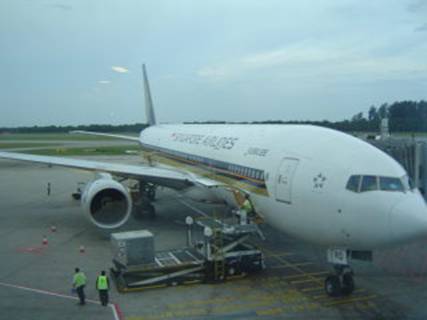 We will be staying with Don and Ann Brooks near Perth for our first week or so in Australia and are looking forward to meeting Ann and to seeing Don again, having first met him when his holiday in Kerala, India, coincided with our visit to the CGH Earth group of hotels. |
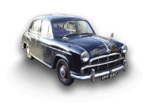 |
 |
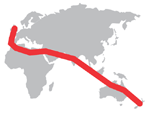 |
|||||||
|
 |
|
|






